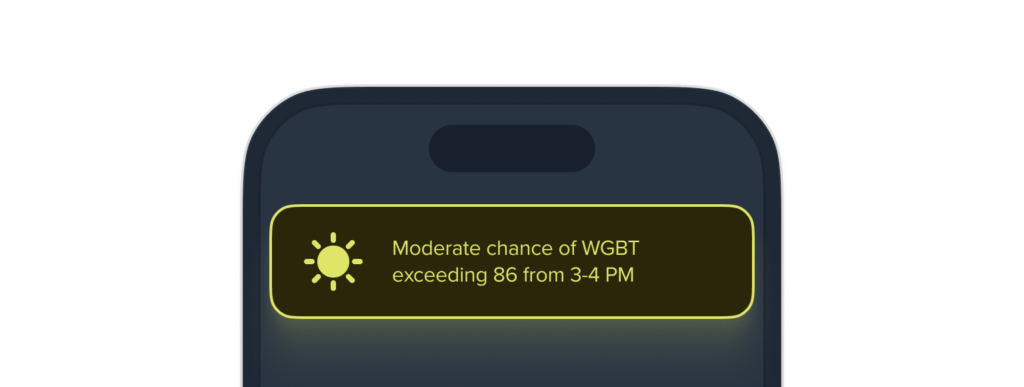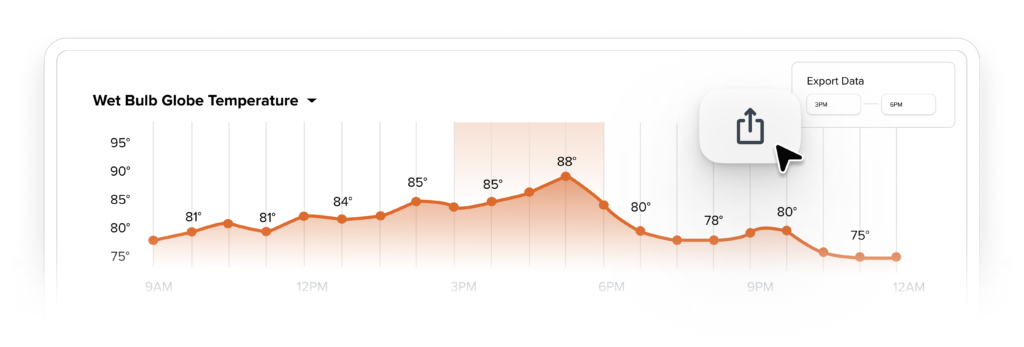Phone WBGT Apps Underestimate Risk (and What ATs Should Do)
As an Athletic Trainer, you make critical safety decisions based on the data you’re given. But what if the Wet Bulb Globe Temperature (WBGT) reading from your free WBGT app, like Zelus WBGT, is fundamentally flawed?
A recent University of Georgia study confirmed this very risk, finding that free WBGT apps can read cooler than reality by a staggering 4°F under high-risk conditions.
Researchers compared a popular smartphone WBGT app against on-site measurements, with 1,056 paired readings at 26 high schools in 11 states. The app trended lower by about 1°C on average and by 2–3°C at higher, more dangerous levels. That is roughly 3.6–5.4°F below actual conditions.
That might not sound dramatic, but when 90°F WBGT means canceling or modifying practice, a 4°F miss can push you into dangerous territory without knowing it. Keep reading to learn why your free WBGT app falls short and what you can use instead.
TL;DR for busy ATs: Why Free WBGT Apps Fall Short
- Free smartphone WBGT apps can underestimate risk by ~4°F in high heat, which pushes practice into the wrong category, especially on hot, sunny fields where risk is highest. This common misread can place your practice in the wrong safety category.
- WBGT is the Gold Standard: WBGT is superior to temperature or heat index because it factors in air temperature, sun, wind, solar radiation, and humidity. It’s the required standard in elite sports and military settings for a reason.
- On-Site Automation is the Solution: Professional, on-site systems like Perry Weather eliminate guesswork. Automated alerts, shared countdown timers, and effortless digital logs make safety decisions clear, consistent, and defensible.
- Time Savings are Real: A recent survey conducted by Perry Weather showed that school districts report saving 40+ staff hours per sports season by replacing the tedious cycle of manual checks, handwritten logs, and fragmented communication with an automated platform.
What the University of Georgia Study Found
The UGA study wasn’t a small-scale observation; it was an extensive, multi-state investigation that was one of the largest WBGT accuracy tests ever conducted:
- Scope: The study included 1,056 paired readings at 26 different high schools across 11 states, covering a variety of surfaces and climate zones.
- Methodology: Researchers compared readings from a popular smartphone WBGT app against a research-grade, on-site device (Kestrel 5400), the longtime standard for manual measurement.
- The Result: The phone app’s WBGT readings averaged about 1.8°F (1°C) lower than the on-site device, but the bias grew significantly as conditions worsened. At higher, more dangerous WBGT levels, the app was frequently 3.6°F to 5.4°F (2-3°C) cooler than reality.
- The Impact: This error margin meant the phone app consistently placed conditions in a lower, less restrictive activity-modification category than the on-site reading required. It delayed mandatory breaks, equipment removal, and in the most extreme cases, full practice cancellations.
The study’s public summary is direct: the app underestimates the need for critical safety actions. For an AT, this means you may think you are compliant with your heat policy when you are not.
Why Your App Under-Reads Your Field: The Science of the Flaw
Free smartphone weather apps are convenient, but that convenience comes from cutting critical scientific corners. They fail to provide accurate WBGT for several key reasons:
- Remote Data vs. On-Site Reality: Apps don’t have physical sensors. They pull data from regional forecast grids or airport weather stations that can be miles away from your campus. This remote data cannot account for your specific microclimate.
- The Microclimate Factor: An athletic campus is a heat island. Artificial turf and black track surfaces absorb and radiate immense heat. Stadium bowls trap humidity and block cooling winds. A weather report from an airport ten miles away will never capture these hyper-local conditions.
- Estimation vs. Direct Measurement: True WBGT requires three physical sensors: a black globe sensor for radiant heat, a shaded thermometer for ambient temperature, and a wet-bulb measure for humidity’s effect on evaporative cooling.
Apps estimate these inputs using algorithms. They don’t measure them. An on-site system like Perry Weather uses professional-grade sensors to directly measure the environment where your athletes train. - No Defensible Paper Trail: If a heat-related incident occurs, a screenshot from a free app is not a compliance record. It’s a piece of data from a scientifically questioned source.
“But My Handheld Kestrel Is Good Enough, Right?”
A properly used handheld meter like a Kestrel is certainly more accurate than an app because it measures the on-site environment. However, its effectiveness is entirely dependent on perfect, consistent human execution—a major challenge in the chaotic reality of a high school practice.
The problems with relying solely on handhelds are practical and significant:
- Stabilization Time: A handheld device needs 15-20 minutes to acclimate to the outdoor environment to provide an accurate reading. Under pressure, this critical step is often skipped.
- Inconsistent Placement: A reading taken in the shade of a press box is vastly different from one taken in direct sun at the 50-yard line of a turf field.
- The “One Device, Many Fields” Problem: A single AT cannot be at the tennis courts, the soccer field, and the football stadium at the same time.
- Manual Logging & Communication: This workflow relies on someone remembering to take readings, write them down, and then communicate the changes to every coach and staff member—a process ripe for error and delay.
As the athletic staff at Farmington School District (MO) noted, the manual handheld process “was horrible. Took forever, accuracy questionable.” On-site, automated systems are designed to eliminate this human error and inconsistency by design.
Real-World Problems Perry Weather Solves That Free WBGT Apps Don’t
The gap between a free app and a professional system becomes clear when you face real-world scenarios that demand more than just a number on a screen.
The Perry Weather Solution: Every reading, alert, and decision is automatically captured in a digital log. With one click, you can export a clean, timestamped timeline that serves as undeniable proof of timely, policy-based action.
The Problem: Communicating Without Chaos
App/Handheld Reality: A WBGT threshold is crossed. You now have to start a messy group text, make multiple phone calls, and hope every coach gets the message and acts on it.
The Perry Weather Solution: Perry Weather automatically pushes a mobile alert with clear instructions to every coach, AT, and administrator simultaneously. Optional sirens, strobes, and PA system integrations provide immediate, field-wide clarity.

In Their Words (Bishop Lynch, TX): “It’s not just me out there checking temperatures or storms anymore. Our whole staff is informed… it just looks and feels more professional.”
The Problem: Creating a Defensible Compliance Record
App/Handheld Reality: Your compliance record is a collection of handwritten notes on a clipboard or inconsistent screenshots. In an audit or incident review, this is difficult to defend.
The Perry Weather Solution: Every reading, alert, and decision is automatically captured in a digital log. With one click, you can export a clean, timestamped timeline that serves as undeniable proof of timely, policy-based action.

In Their Words (Tampa Prep, FL): “Having one source now with Perry Weather… backs us as admin and athletic trainers… one standard we’re all going by.”
Perry Weather vs. Free Apps: The AT’s Choice
| Decision Need | Free WBGT App (e.g., Zelus) | Perry Weather (On-Site System) |
| Accuracy in High Heat | Often 3.6–5.4°F cooler at higher WBGT | Measures true on-field WBGT in sun, wind, and humidity |
| Data Source | Remote airport stations and algorithmic estimates | Professional-grade sensors located on your campus |
| Policy Execution | Manual interpretation and judgment calls | Automated thresholds with clear, pre-set instructions |
| Return-to-Play Timers | A stopwatch on someone’s phone | Shared, automated countdown timers |
| Communication | Fragmented text threads and phone calls | Mass mobile alerts plus optional siren, strobe, and PA |
| Recordkeeping | Manual notes and questionable screenshots | Automatic, exportable digital logs |
The Safer Way for Athletic Trainers: Perry Weather
Say goodbye to guesswork. Perry Weather is built for athletic trainers who need blind trust in their heat data:
- Instant alerts when WBGT crosses safety thresholds—automated to stop practice or initiate cooldowns.
- Auto-logged readings and decisions, ideal for audits and unexpected incidents.
- Countdown timers for cool-down breaks based on PPE-adjusted WBGT guidelines.
- On-site accuracy guaranteed—even in sun, humidity, and wind that fool apps.
- Infrastructure integration with school PA systems, alert lights, and badge gates.
To paraphrase UGA: apps can inadvertently put athletes at risk—but on-site measurement systems like Perry Weather are the only way to reliably protect them.The Professional Standard: Proven Results from a National Survey
Benefit #1: Reclaim Your Most Valuable Asset—Time
- ATs reported a 43% average reduction in time spent on WBGT readings, which equates to an estimated 40 hours saved every football season.
- 54% of ATs who previously used Kestrels or free apps saved 1-3 hours per week with Perry Weather’s automation.
- Overall, over 75% of surveyed ATs said Perry Weather “significantly reduced” the time they spent on weather duties.
This time is reallocated directly to athlete care, rehab, and injury prevention. As Mike Hopper, Head Athletic Trainer at Bishop Lynch High School, stated,
“I got into athletic training to help kids, not to be a meteorologist. Perry Weather handles the weather monitoring, so I can do my job faster and focus on the athletes”.
Benefit #2: End the Arguments and Unify Your Staff
Inconsistency and second-guessing are major sources of friction in athletic programs. Automation and a single source of truth eliminate this.
- Surveyed ATs reported a 58% drop in weather-related schedule disputes with coaches after implementing Perry Weather.
- 85% reported improved communication with coaches and staff through automated alerts and centralized dashboards.
Policy-driven alerts are tied directly to your safety protocols, removing the need for trainers to manually explain or justify actions. The system makes the call, ensuring every team adheres to the same standard.
Benefit #3: Make Every Call with Unwavering Confidence
The survey found that reliability and precision were the top reasons trainers switched to Perry Weather. This directly translated to a massive increase in their confidence to make the right call.
- 90% of athletic trainers said Perry Weather improved the accuracy and trustworthiness of their safety decisions.
- The average confidence score in their WBGT data jumped from 6 out of 10 before Perry Weather to 9.4 out of 10 after.
- Crucially, ATs reported zero lightning “false clears” after adopting Perry Weather, compared to an average of two per season with free apps.
Conclusion: A New Standard for Athletic Weather Safety
The evidence is overwhelming. The scientific data from the UGA study and the real-world results from the 2025 Athletic Trainer Survey point to the same conclusion: the era of relying on apps and handhelds for WBGT monitoring and athlete safety is over.
By replacing outdated handheld devices and unreliable free weather apps, Perry Weather eliminates uncertainty and delay. The results are clear: ATs gain confidence in every safety call, teams avoid unnecessary disruptions, and student-athletes stay safe, focused, and in the game.
Ready to Raise Your Heat Game?
If you are still trusting a free app or a manual-check system to keep your students safe, you are making critical decisions with unreliable data.
It’s time to upgrade to the professional standard that provides real readings, clear triggers, and undeniable proof you acted to protect your athletes. Perry Weather removes the guesswork from weather safety decisions—try it yourself with a free two-week trial.










